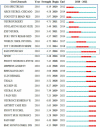Research Hotspots and Effectiveness of Transcranial Magnetic Stimulation in Pain: A Bibliometric Analysis
- PMID: 35814960
- PMCID: PMC9264350
- DOI: 10.3389/fnhum.2022.887246
Research Hotspots and Effectiveness of Transcranial Magnetic Stimulation in Pain: A Bibliometric Analysis
Abstract
Transcranial magnetic stimulation, as a relatively new type of treatment, is a safe and non-invasive method for pain therapy. Here, we used CiteSpace software to visually analyze 440 studies concerning transcranial magnetic stimulation in pain research from 2010 to 2021, indexed by Web of Science, to clarify the research hotspots in different periods and characterize the process of discovery in this field. The United States ranked first in this field. Lefaucheur JP, Fregni F, and Andrade ACD made great contributions to this field of study. The most prolific institution was University of São Paulo. The four main hot keywords were neuropathic pain, motor cortex, connectivity, and non-invasive brain stimulation. There were three main points that were generally accepted: (1) definite analgesic effect of high-frequency rTMS of M1 contralateral to pain side in neuropathic pain; (2) there are inconclusive recommendations regarding rTMS of the dorsolateral prefrontal cortex (DLPFC) in fibromyalgia and neuropathic pain; (3) there is low-quality evidence that single doses of high-frequency rTMS of the motor cortex may have short-term effects on chronic pain. This bibliometric analysis indicated that prospective, multi-center, large-sample, randomized controlled trials are still needed to further verify the effectiveness of various transcranial magnetic stimulation parameters in pain research.
Keywords: CiteSpace; Web of Science; citation burst; pain; transcranial magnetic stimulation.
Copyright © 2022 Li, Sun and Tian.
Conflict of interest statement
The authors declare that the research was conducted in the absence of any commercial or financial relationships that could be construed as a potential conflict of interest.
Figures









Similar articles
-
Trends of Repetitive Transcranial Magnetic Stimulation From 2009 to 2018: A Bibliometric Analysis.Front Neurosci. 2020 Feb 26;14:106. doi: 10.3389/fnins.2020.00106. eCollection 2020. Front Neurosci. 2020. PMID: 32174808 Free PMC article.
-
Research hotspots and effectiveness of repetitive transcranial magnetic stimulation in stroke rehabilitation.Neural Regen Res. 2020 Nov;15(11):2089-2097. doi: 10.4103/1673-5374.282269. Neural Regen Res. 2020. PMID: 32394967 Free PMC article.
-
Evidence-based guidelines on the therapeutic use of repetitive transcranial magnetic stimulation (rTMS): An update (2014-2018).Clin Neurophysiol. 2020 Feb;131(2):474-528. doi: 10.1016/j.clinph.2019.11.002. Epub 2020 Jan 1. Clin Neurophysiol. 2020. PMID: 31901449 Review.
-
Effects of repeated transcranial magnetic stimulation in the dorsolateral prefrontal cortex versus motor cortex in patients with neuropathic pain after spinal cord injury: a study protocol.BMJ Open. 2022 Mar 11;12(3):e053476. doi: 10.1136/bmjopen-2021-053476. BMJ Open. 2022. PMID: 35277402 Free PMC article.
-
Repetitive transcranial magnetic stimulation for neuropathic pain: a randomized multicentre sham-controlled trial.Brain. 2021 Dec 16;144(11):3328-3339. doi: 10.1093/brain/awab208. Brain. 2021. PMID: 34196698 Clinical Trial.
Cited by
-
Status and trends of TMS research in depressive disorder: a bibliometric and visual analysis.Front Psychiatry. 2024 Aug 8;15:1432792. doi: 10.3389/fpsyt.2024.1432792. eCollection 2024. Front Psychiatry. 2024. PMID: 39176225 Free PMC article.
-
Research Hotspots and Frontiers of Transcranial Direct Current Stimulation in Stroke: A Bibliometric Analysis.Brain Sci. 2022 Dec 21;13(1):15. doi: 10.3390/brainsci13010015. Brain Sci. 2022. PMID: 36671997 Free PMC article. Review.
-
Current status and trends in the study of intestinal flora in cognitive disorders: a bibliometric and visual analysis.Front Microbiol. 2025 May 27;16:1577597. doi: 10.3389/fmicb.2025.1577597. eCollection 2025. Front Microbiol. 2025. PMID: 40497058 Free PMC article. Review.
-
Bibliometric Analysis of Brain Stimulation Technologies in Sleep Disorders.Med Sci Monit. 2024 Mar 5;30:e942687. doi: 10.12659/MSM.942687. Med Sci Monit. 2024. PMID: 38439525 Free PMC article.
-
Thirty-year survey of bibliometrics used in the research literature of pain: Analysis, evolution, and pitfalls.Front Pain Res (Lausanne). 2023 Mar 1;4:1071453. doi: 10.3389/fpain.2023.1071453. eCollection 2023. Front Pain Res (Lausanne). 2023. PMID: 36937565 Free PMC article. Review.
References
LinkOut - more resources
Full Text Sources

